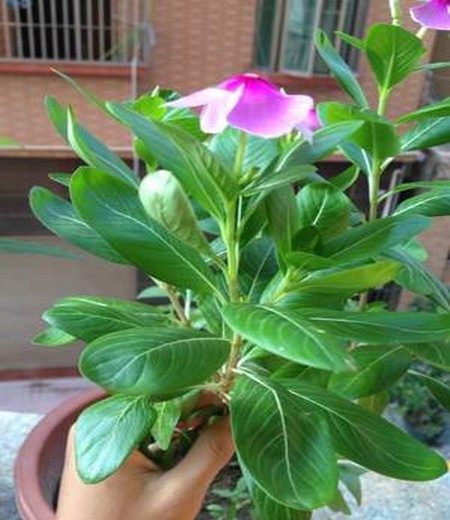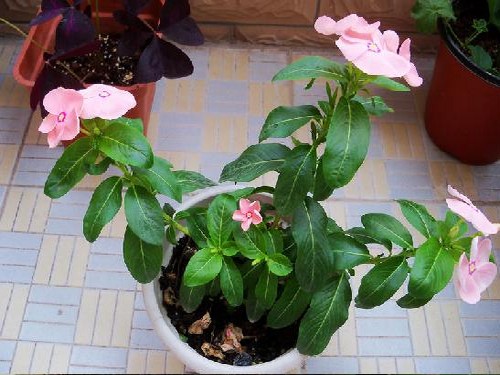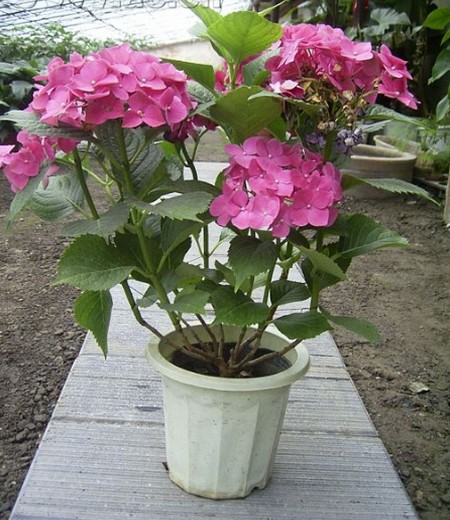How to raise Catharanthus roseus? Culture techniques of Catharanthus roseus
Catharanthus roseus has a long flowering period, beautiful colors and beautiful posture, and with the development of modern technology, the varieties of Catharanthus roseus cultivated by people are becoming more and more beautiful, which is very suitable for indoor potted ornamental plants. Raising a pot at home may have an unexpected effect. So how to plant Catharanthus roseus? Next, let's take a look at the editor's introduction of Catharanthus roseus culture technology.

1. Propagation: Catharanthus roseus is used to sow seeds and raise seedlings, but it can also be cut, but its growth is not as good as that of sowing. The seeds of Catharanthus roseus should be picked with ripening, the optimum temperature for germination is 20-25 ℃, sowing should be carried out from March to May, and annual cultivation should be carried out. Most of the cuttings are carried out from April to July, but this method is not usually used.
2. Soil: Catharanthus roseus is suitable for fertile, loose, well-drained sandy soil or soil rich in humus, resistant to barren soil, but most avoid saline-alkali land. The clayey soil with hardening and poor permeability is easy to make the plant grow badly, the leaves turn yellow and do not blossom. Natural leather, soil requirements are not strict, suitable for the use of ordinary garden soil, avoid salt and alkali; ventilated sand or rich in humus is the best.
3. Sunshine: Catharanthus roseus is a light-loving plant, and sufficient sunlight must be ensured during its growth, so as to make its leaves green and shiny and colorful. If the periwinkle is always kept in the shade, it is prone to diseases and insect pests, and the leaves are yellow and deciduous. Like sufficient light, if the light is not enough, it is easy to grow, affect flowering, ornamental will be discounted.
Temperature: Catharanthus roseus likes heat, but is not resistant to cold. The suitable growth temperature is between 20 and 30 degrees; for a long time below 15 degrees, the growth will slow down or even stop, resulting in dormancy. It is easy to suffer frost injury below 5 degrees. The most suitable temperature for growth is 18-24 ℃ from March to July, and 13-18 ℃ from September to March of the following year. The winter temperature should not be lower than 10 ℃ to avoid death from frostbite.
5, watering: Catharanthus roseus avoid dampness and fear of waterlogging, watering should not be too much, stagnant water is easy to root rot, and then affect the growth. Indoor winter should be more strictly controlled watering, it is appropriate to dry, otherwise easy to freeze. If the open field cultivation, summer showers should pay attention to drainage, so as to avoid stagnant water to death. If you look at the dry and wet topsoil, it will be watered thoroughly; for example, if the temperature is high in summer and the growth is fast, it can be watered every 2-3 days; in spring and autumn, it grows slowly, and it can be watered every 5-7 days. It is basically dormant in winter and can be watered once a month.
6. Fertilization: Catharanthus roseus does not have strict requirements for fertilizer. It can be fertilized every ten days or so during the growth period, and compound fertilizer and liquid fertilizer can be applied in turn. Potted Catharanthus roseus needs to be covered with a layer of base fertilizer at the bottom of the pot to ensure sufficient nutrients for plant growth. Suitable for the use of phosphorus and potassium fertilizer, such as ornamental grass flowers with the big fat king, suitable for the growing period, flowering period.
7. Pruning: Catharanthus roseus is a perennial herb, which is more suitable for potted plants, but the potted plants should be pruned so as not to let the plants grow too high, affecting the decoration and ornamental effect. Usually after the pot survives, it is necessary to pick the heart several times to make it more branched and blossom, and the residual flowers must be cut off after flowering. The peak growth period is available, which is suitable for the three seasons of spring, summer and autumn, mainly cutting off the branches of diseases and insects, thin and weak branches; only long leaf branches can be cut short. Promote the branch, after 5-10 leaves of a single plant, carry on the coring. During the whole growth process, the heart can be removed many times until the plant type is satisfied.
8. Diseases and insect pests: plants are strong and rarely occur diseases and insect pests. Catharanthus roseus itself is poisonous, so it is more resistant to diseases and insect pests, mainly including seedling quenching disease, gray mold and red spiders, aphids, tea moths and other diseases and insect pests. Cultivation should pay attention to ventilation, drainage and loosening the soil, can not be caught in the rain, if diseases and insect pests have occurred, timely measures should be taken to reduce or remove the harm. The ability of disease resistance is strong and it is not suitable to be infected with insect pests. If there are bacterial diseases, it can be controlled with carbendazim or chlorothalonil 1000 times aqueous solution, and can also be treated with 65% Dysen zinc solution.
Time: 2019-06-01 Click:
- Prev

Culture methods and matters needing attention of Catharanthus roseus
Catharanthus roseus is a kind of flower and plant we often see, which can be seen in roadside flower beds and other places. The flowers are very bright and prosperous. In fact, Catharanthus roseus is very suitable for planting in potted plants to decorate the home.
- Next

Culture methods and matters needing attention of potted eight Immortals (Hydrangea)
There are a variety of breeding methods for eight Immortals (Hydrangea). Let's start with the most familiar ones. Cutting, this method is unknown to everyone, which is like inadvertently cutting willow into shade. Cut off the fresh shoots at the top and insert them into the soil at about 15 degrees in spring. The second is the strip pressing method.
Related
- Fuxing push coffee new agricultural production and marketing class: lack of small-scale processing plants
- Jujube rice field leisure farm deep ploughing Yilan for five years to create a space for organic food and play
- Nongyu Farm-A trial of organic papaya for brave women with advanced technology
- Four points for attention in the prevention and control of diseases and insect pests of edible fungi
- How to add nutrient solution to Edible Fungi
- Is there any good way to control edible fungus mites?
- Open Inoculation Technology of Edible Fungi
- Is there any clever way to use fertilizer for edible fungus in winter?
- What agents are used to kill the pathogens of edible fungi in the mushroom shed?
- Rapid drying of Edible Fungi

